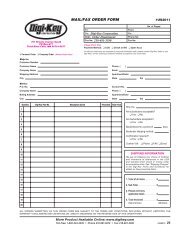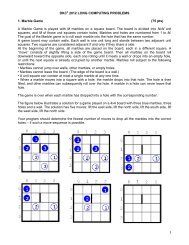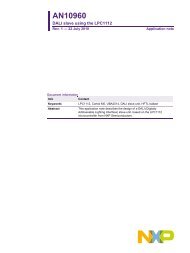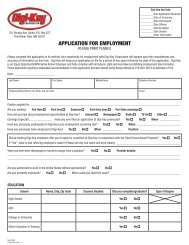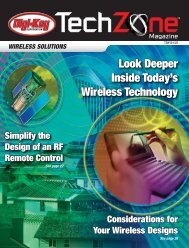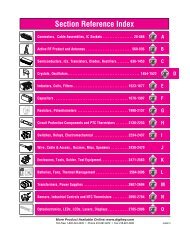Microcontroller Solutions TechZone Magazine, April 2011 - Digikey
Microcontroller Solutions TechZone Magazine, April 2011 - Digikey
Microcontroller Solutions TechZone Magazine, April 2011 - Digikey
Create successful ePaper yourself
Turn your PDF publications into a flip-book with our unique Google optimized e-Paper software.
6. If not, it attempts to retransmit its message. It will still have to go<br />
through the priority process with other messages.<br />
7. All other nodes also abandon reading the current frame, and<br />
adds four to each REC (Receive Error Counter) register.<br />
8. Any nodes that have messages queued up for transmission will<br />
transmit now. All others start listening to the bus.<br />
9. Hopefully, this time the message(s) will be broadcast and<br />
received error free. Each time a frame is transmitted and/or<br />
received successfully, the corresponding TEC and REC registers<br />
are decremented (usually by only one).<br />
TIP: Error counters These are two 8-bit registers in every CAN<br />
controller and you can read these with your software. This is a good<br />
idea because it gives some indication of general bus health and<br />
stability. In a good CAN network, TEC and REC will equal zero. If it<br />
starts having higher values, something has happened to your network.<br />
The usual suspect is bad hardware. The problem is usually in either<br />
the wires or the transceiver chip.<br />
Don’t forget that if something happens to the integrity of the twisted<br />
pair, such as CAN Lo disconnected; it might still work but with greatly<br />
reduced noise immunity (that is what differential signals do best). If<br />
the network is in a very noisy environment, there might be a lot more<br />
transient bus errors. This is very tricky to debug without knowledge of<br />
the REC and TEC register contents. Put this in the software and report<br />
it to the diagnostic routines.<br />
In a general sense, TEC represents a given node’s errors and REC<br />
indicates the other nodes’ errors.<br />
Bus off: As mentioned, if a transmitting node detects it has put too<br />
many bad frames on the bus, it will disconnect itself. It will assume<br />
that there is something very wrong with itself. To get back on the bus<br />
depends on how the controller is configured. It can take a controller<br />
RESET or a certain number of good frames received or what is<br />
configured to get back on.<br />
TIP: How can you create a Bus Error for testing<br />
Have a node send a message at the wrong frequency. When this<br />
frame tries to get on the bus, this is certain to create a bus error<br />
condition. Some CAN controllers can send a one-shot frame.<br />
BUS faults<br />
This is different from a bus error. We normally think of a bus fault as<br />
something that has happened to the “wires” or the output transistors<br />
of the transceiver chip. Not all bus faults will result in a bus error. A bus<br />
error can be thought of as the CAN controllers’ reaction to a problem on<br />
the bus such as noise, faulty node that includes a bus fault.<br />
What happens if one of the twisted pair opens or is shorted out<br />
CAN has an automatic mechanism for this. Not all transceiver chips<br />
implement all of them. You can usually short CAN Lo to ground (ISO<br />
11898 says CAN short Hi also) or open one CAN line. The ground needs<br />
to be connected for these to function. You cannot short both Hi and<br />
Lo together (Fault Tolerant will work) or open both up. You can cut the<br />
ground or have a large ground loop present and CAN will still work.<br />
These will be detected as a bus error as described above. At least one<br />
node must try to transmit a frame in a bus fault condition to trigger a<br />
bus error. A bus in idle mode cannot trigger a bus error. When the bus<br />
fault is removed, in many systems the network will come back alive,<br />
if so configured. CAN has excellent noise immunity because of the<br />
twisted pair. The common mode noise gets cancelled out and the CAN<br />
signal is not affected (because it is 180 degrees out of phase).<br />
The ground: The ground is not needed for CAN operation if the<br />
twisted pair is intact. This is readily shown with simple experiments.<br />
One experiment showed a small network still worked properly with<br />
two nodes having a 40 volts DC ground difference.<br />
However, it is a good idea to include a good ground in the system<br />
design. Some bus faults need the ground to allow the transceiver<br />
to compensate.<br />
Here are some bonus items that are not part of the CAN specification<br />
that might prove helpful in your system:<br />
1) Transmitting data sets greater than 8 bytes:<br />
Clearly, transmitting a data set greater than 8 bytes will take multiple<br />
frames and this will require some planning. Such schemes can<br />
become very complicated as they have to deal with a wide-ranging<br />
set of contingencies. By focusing on a narrow requirement set, design<br />
of a simpler protocol is possible.<br />
Most current schemes use the first data byte to contain the number of<br />
total data bytes to follow plus a counter to help determine which data<br />
byte is which. The ID usually identifies the node plus whether it is a<br />
request or response message. To use an existing protocol, see ISO<br />
15765. This is what automobiles use. This includes OBDII diagnostics<br />
which is public information. This is a good example where one<br />
message can be comprised of many CAN frames.<br />
2) Periodic, Request/Response and Command Frames:<br />
Periodic: This technique sends a frame out periodically – several<br />
times a second is typical. This frame will contain data that any node<br />
can use and is identified by its ID. Examples are speed, position,<br />
pressure and events.<br />
Request/Response: A node sends out a frame requesting certain<br />
specified information. Any other nodes that have the requested<br />
information then put it on the bus. The ID identifies the Request<br />
frame and the Response by changing one bit of the Request ID. ID<br />
0x248 is a Request frame and 0x648 is its Response. The Request<br />
frame data bytes will specify what information is requested. The<br />
Response frame will contain the requested information or an error<br />
message.<br />
Command: A frame commanding some event is performed. The ID<br />
usually contains the address of the commanded node and the data<br />
bytes the actual command(s). Sometimes an acknowledge frame<br />
is returned.<br />
TIP: Consider a blend of these three types of traffic depending on your<br />
system’s needs.<br />
3) Time-outs:<br />
Automotive CAN networks use time-outs. This concept is easily and<br />
effectively transferred to systems in other fields. A time-out occurs<br />
when a node fails to respond to a request in a timely fashion. Timeouts<br />
are handled completely by software. The CAN specification does<br />
not provide this mechanism. A time-out is helpful to recover from<br />
problems with the network such as severe bus errors, catastrophic<br />
bus faults, faulty nodes or intermittent connections.<br />
www.digikey.ca/microcontroller<br />
51



